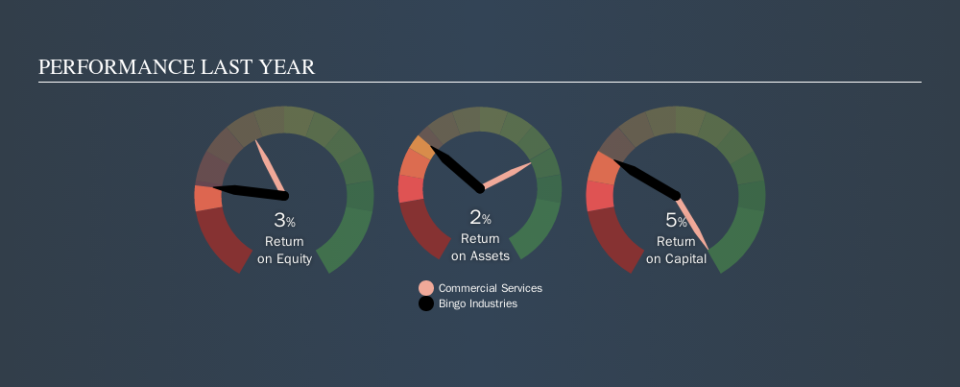Why Bingo Industries Limited’s (ASX:BIN) Use Of Investor Capital Doesn’t Look Great

Today we are going to look at Bingo Industries Limited (ASX:BIN) to see whether it might be an attractive investment prospect. Specifically, we'll consider its Return On Capital Employed (ROCE), since that will give us an insight into how efficiently the business can generate profits from the capital it requires.
Firstly, we'll go over how we calculate ROCE. Next, we'll compare it to others in its industry. And finally, we'll look at how its current liabilities are impacting its ROCE.
Understanding Return On Capital Employed (ROCE)
ROCE is a metric for evaluating how much pre-tax income (in percentage terms) a company earns on the capital invested in its business. Generally speaking a higher ROCE is better. In brief, it is a useful tool, but it is not without drawbacks. Author Edwin Whiting says to be careful when comparing the ROCE of different businesses, since 'No two businesses are exactly alike.'
How Do You Calculate Return On Capital Employed?
Analysts use this formula to calculate return on capital employed:
Return on Capital Employed = Earnings Before Interest and Tax (EBIT) ÷ (Total Assets - Current Liabilities)
Or for Bingo Industries:
0.048 = AU$57m ÷ (AU$1.3b - AU$160m) (Based on the trailing twelve months to June 2019.)
Therefore, Bingo Industries has an ROCE of 4.8%.
View our latest analysis for Bingo Industries
Is Bingo Industries's ROCE Good?
When making comparisons between similar businesses, investors may find ROCE useful. In this analysis, Bingo Industries's ROCE appears meaningfully below the 14% average reported by the Commercial Services industry. This performance could be negative if sustained, as it suggests the business may underperform its industry. Regardless of how Bingo Industries stacks up against its industry, its ROCE in absolute terms is quite low (especially compared to a bank account). Readers may wish to look for more rewarding investments.
Bingo Industries's current ROCE of 4.8% is lower than 3 years ago, when the company reported a 30% ROCE. So investors might consider if it has had issues recently. The image below shows how Bingo Industries's ROCE compares to its industry, and you can click it to see more detail on its past growth.
Remember that this metric is backwards looking - it shows what has happened in the past, and does not accurately predict the future. ROCE can be deceptive for cyclical businesses, as returns can look incredible in boom times, and terribly low in downturns. ROCE is, after all, simply a snap shot of a single year. What happens in the future is pretty important for investors, so we have prepared a free report on analyst forecasts for Bingo Industries.
How Bingo Industries's Current Liabilities Impact Its ROCE
Liabilities, such as supplier bills and bank overdrafts, are referred to as current liabilities if they need to be paid within 12 months. Due to the way ROCE is calculated, a high level of current liabilities makes a company look as though it has less capital employed, and thus can (sometimes unfairly) boost the ROCE. To counteract this, we check if a company has high current liabilities, relative to its total assets.
Bingo Industries has total liabilities of AU$160m and total assets of AU$1.3b. Therefore its current liabilities are equivalent to approximately 12% of its total assets. This is not a high level of current liabilities, which would not boost the ROCE by much.
The Bottom Line On Bingo Industries's ROCE
That's not a bad thing, however Bingo Industries has a weak ROCE and may not be an attractive investment. You might be able to find a better investment than Bingo Industries. If you want a selection of possible winners, check out this free list of interesting companies that trade on a P/E below 20 (but have proven they can grow earnings).
If you are like me, then you will not want to miss this free list of growing companies that insiders are buying.
We aim to bring you long-term focused research analysis driven by fundamental data. Note that our analysis may not factor in the latest price-sensitive company announcements or qualitative material.
If you spot an error that warrants correction, please contact the editor at editorial-team@simplywallst.com. This article by Simply Wall St is general in nature. It does not constitute a recommendation to buy or sell any stock, and does not take account of your objectives, or your financial situation. Simply Wall St has no position in the stocks mentioned. Thank you for reading.

